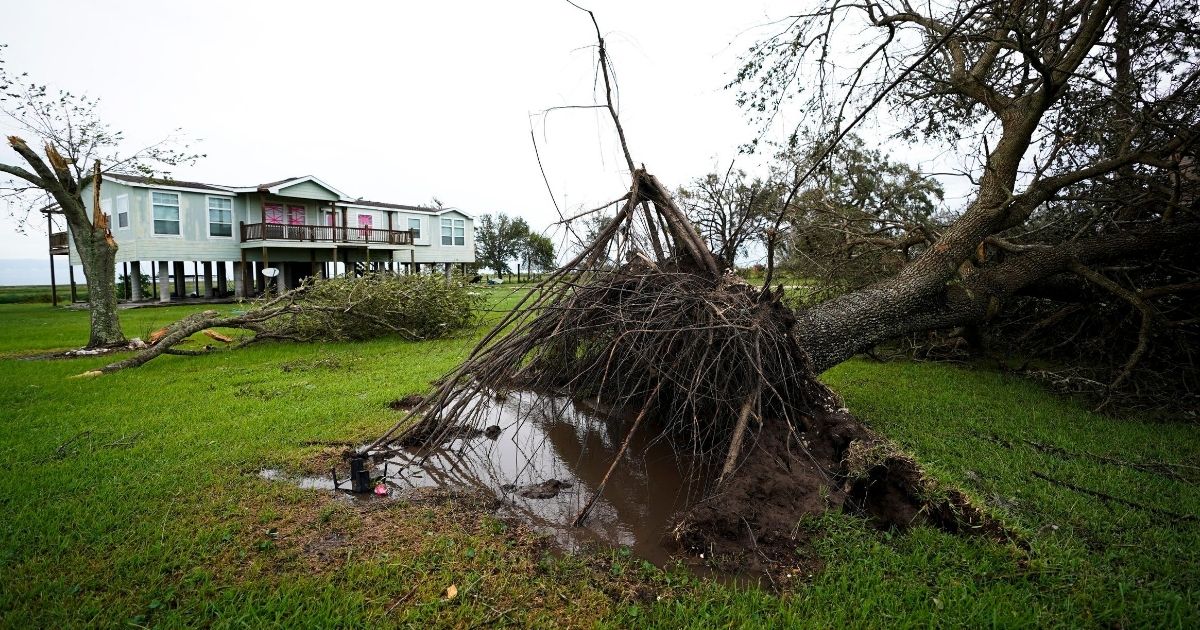
Hurricane Laura Roars Ashore, Rendering Certain Areas 'Unsurvivable'
Hurricane Laura pounded the Gulf Coast with ferocious winds and torrential rain and unleashed a wall of seawater that could push 40 miles inland as the Category 4 storm roared ashore Thursday in Louisiana near the Texas border.
Laura battered a tall building in Lake Charles, blowing out windows as glass and debris flew to the ground. Police spotted a floating casino that came unmoored and hit a bridge. But hours after the hurricane made landfall, the wind and rain were still blowing too hard for authorities to check for survivors.
Hundreds of thousands of people were ordered to evacuate ahead of the hurricane, but not everyone fled from the area, which was devastated by Hurricane Rita in 2005.
“There are some people still in town, and people are calling … but there ain’t no way to get to them,” Tony Guillory, president of the Calcasieu Parish Police Jury, said over the phone from a Lake Charles government building that was shaking from the storm.
Guillory said he hoped the stranded people could be rescued later in the day, but he feared that blocked roads, downed power lines and floodwaters could get in the way.
“We know anyone that stayed that close to the coast, we’ve got to pray for them, because looking at the storm surge, there would be little chance of survival,” Louisiana Lt. Gov. Billy Nungesser told ABC’s Good Morning America.
With nearly 470,000 homes and businesses without power in the two states, near-constant lightning provided the only light for some.
The National Hurricane Center said Laura slammed the coast with winds of 150 mph at 1 a.m. CDT near Cameron, a 400-person community about 30 miles east of the Texas border. Forecasters had warned that the storm surge would be “unsurvivable” and the damage “catastrophic.”
They predicted a storm surge of 15 to 20 feet in Port Arthur, Texas, and a stretch of Louisiana including Lake Charles, a city of 80,000 people on Lake Calcasieu.
“This surge could penetrate up to 40 miles inland from the immediate coastline, and floodwaters will not fully recede for several days,” the hurricane center said.
NEW AERIAL VIDEO- extensive damage in Lake Charles, LA. Thanks to our content partners at @LiveStormsMedia @bclemms #ARWX #LAWX pic.twitter.com/C2uFwCmOvf
— Todd Yakoubian (@KATVToddYak) August 27, 2020
Hours after it arrived, Laura remained a Category 2 hurricane, with sustained winds of 100 mph. Its center was moving north, about 20 miles north of Fort Polk, Louisiana. Damaging winds extended outward as far as 175 miles.
A 14-year-old girl in Leesville, Louisiana, was killed when a tree fell on her family’s home, The New Orleans Times-Picayune reported.
Dick Gremillion, the emergency director in Calcasieu Parish, said authorities were unable to get out to assess the damage.
“The wind is still over 50 mph. It’s going to have to drop significantly before they can even run any emergency calls. We also need daylight,” Gremillion said in an interview with Lake Charles television station KPLC.
But in Cameron Parish, where Laura came ashore, Nungesser said 50 to 150 people refused pleas to leave and planned to endure the storm, some in elevated homes and even recreational vehicles. The result could be deadly.
Watch as Hurricane #Laura‘s powerful winds flip over an RV in Lake Charles, Louisiana: https://t.co/Nb7hWJHYg0 pic.twitter.com/XyNOsloo1u
— AccuWeather (@accuweather) August 27, 2020
More than 580,000 coastal residents were ordered to join the largest evacuation since the coronavirus pandemic began and many did, filling hotels and sleeping in cars since officials did not want to open large shelters that could invite more spread of COVID-19.
“It’s a very sad situation,” said Ashley Buller, assistant director of emergency preparedness. “We did everything we could to encourage them to leave.”
Becky Clements, 56, did not take chances. She evacuated from Lake Charles after hearing that it could take a direct hit. With memories of Rita’s destruction almost 15 years ago, she and her family found an Airbnb hundreds of miles inland.
“The devastation afterward in our town and that whole corner of the state was just awful,” Clements recalled. “Whole communities were washed away, never to exist again.”
Significant damage all over Lake Charles #Laura pic.twitter.com/6v2a9CWIkG
— Aaron Rigsby (@AaronRigsbyOSC) August 27, 2020
Federal Emergency Management Agency Administrator Pete Gaynor urged people in Laura’s path to stay home, if that’s still safe. “Don’t go out sightseeing. You put yourself, your family at risk, and you put first responders at risk,” he told “CBS This Morning.”
FEMA has plenty of resources staged to help survivors, Gaynor said. Louisiana Gov. John Bel Edwards mobilized the National Guard to help, and state Department of Wildlife crews had boats prepared for water rescues.
Forecasters expected a weakened Laura to cause widespread flash flooding in states far from the coast.
An unusual tropical storm warning was issued as far north as Little Rock, where forecasters expected gusts of 50 mph and a deluge of rain through Friday.
The storm was so powerful that it could regain strength after turning east and reaching the Atlantic Ocean, potentially threatening the densely populated Northeast.
Laura hit the U.S. after killing nearly two dozen people on the island of Hispaniola, including 20 in Haiti and three in the Dominican Republic, where it knocked out power and caused intense flooding.
It was the seventh named storm to strike the U.S. this year, setting a new record for U.S. landfalls by the end of August.
The old record was six in 1886 and 1916, according to Colorado State University hurricane researcher Phil Klotzbach.
The Western Journal has reviewed this Associated Press story and may have altered it prior to publication to ensure that it meets our editorial standards.
Truth and Accuracy
We are committed to truth and accuracy in all of our journalism. Read our editorial standards.
Advertise with The Western Journal and reach millions of highly engaged readers, while supporting our work. Advertise Today.












